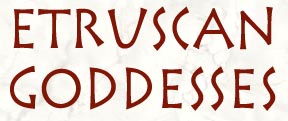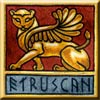
The Etruscan language is a peculiar one; it is not part of the Indo-European family like Latin or Greek but its own unrelated thing of presumably indigenous origins. We do know the alphabet, a version of Greek which the Etruscans adapted for their own use when they came in contact with those people; but most of the Etruscan writing we have is of a funerary character and so short and formulaic, with very few longer texts. That said, these days it can be successfully read, though vocabulary lists are of course on the short side. There was apparently once much more—there are mentions of Etruscan drama, but unfortunately that has all been lost (or simply not found yet, if one is of an optimistic nature). Much of the information on Goddesses is likewise sparse, confined to a name identifying a character on a mirror with no attendant mythology; also, a lot of the scholarship on the Etruscans is in German, which I don't read. I have done my best. Etruscan Deities seem to have been originally thought of in somewhat abstract terms. Under Greek influence the Etruscans adopted a more concrete and iconic tradition, depicting and naming individual Deities, many of Whom they named with Greek names, though adapted to the peculiarities of their language. They also in some cases changed the Greek myths to suit their own inclinations better. But there is still often overlap and a lack of defined characteristics to some of the Etruscan Gods, at least when compared to their neighbors the Romans. This may also explain why some Deities can be either female or male, depending on the depiction. As far as Goddesses go, the Etruscans seem to have quite a few midwives and fate Goddesses; it is also heavy on Underworld Deities and so-called "demons". They are sometimes thought of as a rather gloomy people, but given that most of what we know of them comes from funerary inscriptions and tombs, I'm not sure that's quite fair. At any rate in said tombs they are often depicted enjoying life, feasting and dancing and playing music much like the Egyptians, who were obsessed with the afterlife precisely because they loved the present one so much they wanted it to go on forever. Women do seem to have held a relatively high status among the Etruscans; take for example Thanxvil or Tanaquil, who was a powerful Queen and seeress; also, in many depictions showing both men and women (especially on the engraved hand-mirrors), women are drawn as taller or more central to the composition than the men, or shown as obviously older with a younger lover. Articles below with an * have artwork, by me. Achuvitr*, Alpan, Catha, Cels, Cilens, Culsu, Cupra, Ethausva, Evan, Hinthial, Horta, Lala, Lasa, Leinth, Losna, Malavisch, Mean, Menrfa, Mera, Mlacuch, Munthuch, Nathum, Nortia, Tesana, Thalna, Thanxvil, Thanr, Thesan, Thufltha, Tiv, Tuchulcha, Turan, Uni, Usil, Vanth*, Zipanu. |
